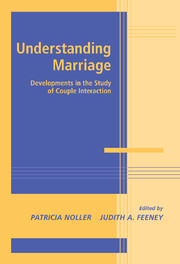Book contents
- Frontmatter
- Contents
- Contribitors
- Introduction
- SECTION ONE THE EFFECT OF COGNITION ON INTERACTION PATTERNS
- SECTION TWO UNDERSTANDING THE IMPORTANCE OF POSITIVE INTERACTION
- Introduction to Section Two
- 5 Observational “Windows” to Intimacy Processes in Marriage
- 6 Bases for Giving Benefits in Marriage: What Is Ideal? What Is Realistic? What Really Happens?
- 7 Shared Participation in Self-Expanding Activities: Positive Effects on Experienced Marital Quality
- SECTION THREE COPING WITH DISAPPOINTMENT, CRITICISM, AND BETRAYAL
- SECTION FOUR POWER, CONFLICT, AND VIOLENCE IN MARITAL INTERACTION
- Marital interaction at important transition periods
- SECTION SIX Interventions for strengthening relationships
- Conclusions
- Index
- References
6 - Bases for Giving Benefits in Marriage: What Is Ideal? What Is Realistic? What Really Happens?
Published online by Cambridge University Press: 25 July 2009
- Frontmatter
- Contents
- Contribitors
- Introduction
- SECTION ONE THE EFFECT OF COGNITION ON INTERACTION PATTERNS
- SECTION TWO UNDERSTANDING THE IMPORTANCE OF POSITIVE INTERACTION
- Introduction to Section Two
- 5 Observational “Windows” to Intimacy Processes in Marriage
- 6 Bases for Giving Benefits in Marriage: What Is Ideal? What Is Realistic? What Really Happens?
- 7 Shared Participation in Self-Expanding Activities: Positive Effects on Experienced Marital Quality
- SECTION THREE COPING WITH DISAPPOINTMENT, CRITICISM, AND BETRAYAL
- SECTION FOUR POWER, CONFLICT, AND VIOLENCE IN MARITAL INTERACTION
- Marital interaction at important transition periods
- SECTION SIX Interventions for strengthening relationships
- Conclusions
- Index
- References
Summary
Many, many benefits are given and received within marriages. Such benefits include, among other things, routine services (for example, doing a load of laundry), other services (for example, buying a birthday card for a mother-in-law), goods (for example, a watch), verbal affection (for example, saying, “I love you.”), physical affection (for example, a backrub), emotional support (for example, reassurance that all is OK following a spouse's bad dream), and giving instructions (for example, how to use a new computer). Most people would agree that the everyday giving and acceptance of such benefits is central to the well-being of relationships. Yet, surprisingly little is known about the patterning of the giving and receiving of benefits in relationships. What drives this patterning? What are the consequences of different modes of giving and receiving benefits within marriage?
In this chapter we address these issues. We discuss what we consider to be the ideal norm for giving and accepting benefits (a communal norm) and we discuss just why we consider this norm to be ideal. We also present evidence that members of couples who are about to be married as well as couples who have been married for years agree with us. We then discuss alternative norms that may, and often are, followed in place of a communal norm – norms such as equity and equality. In particular, we discuss when and why people may replace a communal norm with one of these norms.
- Type
- Chapter
- Information
- Understanding MarriageDevelopments in the Study of Couple Interaction, pp. 150 - 176Publisher: Cambridge University PressPrint publication year: 2002
References
- 6
- Cited by



